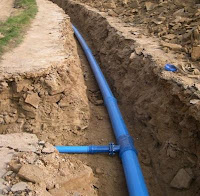3: Routines around water

This is the third in the series about the boring things I do each week, or at least regularly, with my attempt to write in a Spanish angle. We, well the house, has a cesspit. Nothing sophisticated, just a brick-lined hole in the ground. If we were to try and sell the house we'd have to do something about that. Legislation has changed in the years we've lived here. Now we'd either have to put in a decent septic tank or, more likely, dig a big trench to connect our house to the village drain that stops 200 metres from our front door. All the run-off from the washbasins, sink, showers and toilets goes into that cesspit, the black hole, and microorganisms do the rest. Lots of the toilets in Spanish bars, museums and the like have signs asking you to throw soiled toilet paper into a wastebasket. But, good Lord, we're British - we couldn't do that. What about the stench, what about the flies? No, we whizz the paper down the toilet and flush. On one occasion, that caused ...









